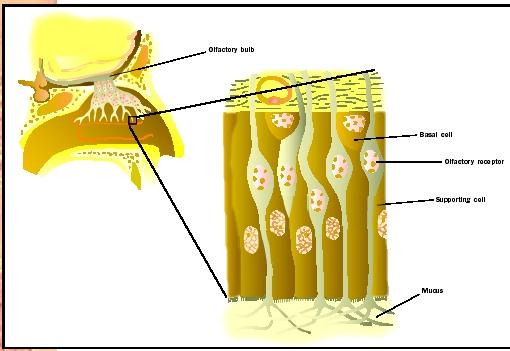Chemoreception
The detection of chemicals by smell, taste, or other means is generally known as chemoreception. A phenomenon that occurs widely in nature, chemoreception is found in the simple chemotaxis of a motile bacterium toward food as well as the more complex interpretative pathways associated with an animal's ability to smell and taste.
Chemicals detected by chemoreception are small molecules that can readily diffuse through a fluid. Airborne odor molecules must be small enough to become volatile (less than 400 molecular mass), and taste molecules are generally soluble in aqueous solutions. Detection of a specific molecule occurs on the outer surface of a receptor cell at a plasma membrane protein known as chemoreceptor. Generally, a chemoreceptor will detect just a single chemical or a small range of structurally similar chemicals. Detection elicits a series of biochemical changes inside the receptor cell. The response of the receptor cell may signal yet other cells in multicellular organisms such as animals or cause a response unique to the sensing cell.
Chemotaxis
Chemoreception that leads to movement of a cell or organism is known as chemotaxis. For example, a simple motile bacterium responds by swimming toward food molecules released by a decomposing organism. In this example of chemoattraction, the bacterium follows an increasing concentration of food molecules to their source. Conversely, the same bacterium might swim away from repellant chemicals released from an unfavorable environment.
In other cases a cell's movement may simply be a change in its shape. For example, in the mating of the single-celled yeast, the nonmotile yeast cells of opposite mating types respond to their mutual detection of complementary pheromones by elongating toward each other. Chemotaxis also plays an important role in chemically directed movement of cells during mammalian development and in human immune cells as they migrate toward invading bacteria near the site of an infected wound.
Smell
The ability to smell odor molecules is known as olfaction. Scientists have estimated that humans can sense over ten thousand different types of smells and that their detection can influence mood, memory, emotions, mate choices, and the immune and endocrine systems.
Olfaction begins with the extremely sensitive detection of odor molecules by one or more of the 12 million receptor cells that line the nasal cavity. Covering this olfactory epithelium is a mucous secretion that may hold some of the more hydrophobic odors to be detected. The chemoreceptors of the olfactory receptor cells are located on nonmotile cilia projecting into the mucous layer. At the other end of these receptor cells are axons that project up through the skull and terminate in the two olfactory bulbs near the front and base of the cerebral hemispheres. From there, olfactory nerve tracts project to the limbic system (an ancient region of the brain concerned

Taste
Gustation is the sense of taste. The tongue is the major organ associated with gustation, and it is the tongue's taste buds that sense the majority of chemicals dissolved in saliva. During gustation receptor cells in taste buds and elsewhere respond and make synaptic contact with cranial nerves VII (serving the anterior two-thirds of the tongue), IX (serving the posterior one-third of the tongue), or X (serving parts other than the tongue, for example, the epiglottis and pharynx ). From there cranial nerve fibers project to the thalamus and then the primary gustatory cortex in the lower parietal lobe of the cerebrum. It is at this final location that the taste is recognized. Commonly recognized tastes are salty, sweet, bitter, sour, and umami (a meaty taste). The flavor of food and drink, often associated solely with taste, is actually a combination of the gustatory and olfactory processes.
SEE ALSO Brain ; Immune Response ; Signaling and Signal Transduction
Michael L. Gleason
Bibliography
Finger, Thomas E., Wayne L. Silver, and Diego Restrepo. The Neurobiology of Taste and Smell, 2nd ed. New York: John Wiley & Sons, 2000.
Gustation: The Sense of Taste. North Carolina State University Online. <http://www.csa.com/crw/web/web-taste.html> .
Olfaction: The Sense of Smell. North Carolina State University Online. <http://www.csa.com/crw/web/web-smol.html> .
Smith, David V., and Robert F. Margolskee. "Making Sense of Taste." Scientific American 284, no. 3 (March 2001): 32–39.
Comment about this article, ask questions, or add new information about this topic: